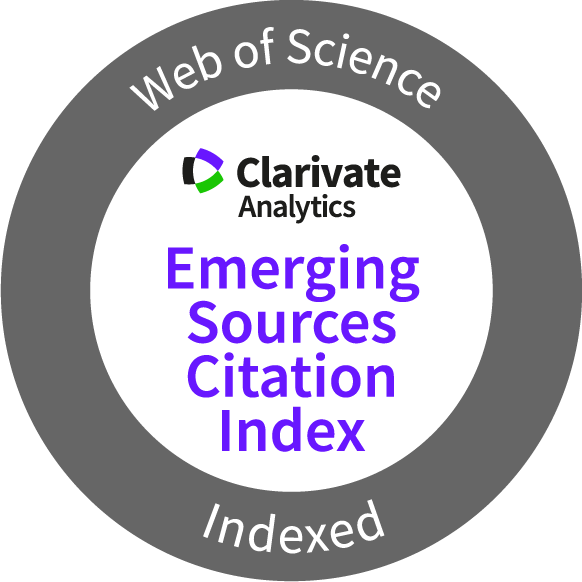Arabidopsis thaliana Stress Associated Protein 2 (AtSAP2) Expression in Response to Salinity and Drought is Regulated by the RAP2.4 Transcription Factor
Keywords:
Arabidopsis, β-glucuronidase (GUS), drought, ERF, salinity, stress-associated proteinAbstract
Plants cannot move to shelter themselves and need to adapt to environmental changes through complex regulatory mechanisms. These adaptations commonly involve the role of stress-related transcription factors (TF). This study explores the role of Ethylene Response Factor (ERF) transcription factor binding sites by examining their distribution within the promoter region of the Arabidopsis thaliana Stress Associated Protein 2 (AtSAP2). Previous studies have highlighted the importance of AtSAP2 in conferring tolerance to plants under abiotic stress, and its ortholog in rice (OsSAP4) has been shown to exhibit increased expression due to ERF binding sites. Thus, understanding the connection between specific ERF sites and the regulation of AtSAP2 is crucial. Analysis of the 2 kb region upstream of the AtSAP2 promoter revealed several Transcription Factor Binding Sites (TFBS), including bZIP, C2H2, CPP, ERF, HD-ZIP, G2-like, MYB, and WRKY. Among these, the Ethylene Response Factor (ERF) binding sites, along with C2H2, are the most abundant in the AtSAP2 promoter. Notably, RAP2.4, an ERF, is significantly predicted to be present in the AtSAP2 promoter (p<0.05). To investigate the relationship between AtSAP2 and RAP2.4 regulation, a promoter study was conducted using Arabidopsis. Two different constructs were generated and transformed into Arabidopsis: Col-0 (pAtSAP2::Col-0) and the rap2.4 mutant (pAtSAP2::rap2.4). The rap2.4 mutant was used to determine whether a mutation in RAP2.4, an ERF, affects AtSAP2 expression through the RAP2.4 binding site. A clear difference in GUS staining activity was observed between pAtSAP2::Col-0 and pAtSAP2::rap2.4. The pAtSAP2::Col-0 plants exhibited blue stain, indicating GUS activity, while no GUS activity was detected in pAtSAP2::rap2.4 plants at either the vegetative (leaf) or inflorescence stage. This suggests that the RAP2.4 protein plays a crucial role in regulating AtSAP2 gene expression through its binding site during abiotic stress.
Downloads
Metrics
References
Basu, C., Kausch, A.P. & Chandlee, J.M. 2004. Use of β-glucuronidase reporter gene for gene expression analysis in turfgrasses. Biochemical and Biophysical Research Communications, 320(1): 7-10. DOI: https://doi.org/10.1016/j.bbrc.2004.05.128
Chen, H., Hwang, J.E., Lim, C.J., Kim, D.Y., Lee, S.Y. & Lim, C.O. 2010. Arabidopsis DREB2C functions as a transcriptional activator of HsfA3 during the heat stress response. Biochemical and Biophysical Research Communications, 401(2): 238-244. DOI: https://doi.org/10.1016/j.bbrc.2010.09.038
Chen, H.Y., Hsieh, E.J., Cheng, M.C., Chen, C.Y., Hwang, S.Y. & Lin, T.P. 2016. ORA47 (octadecanoid-responsive AP2/ERF-domain transcription factor 47) regulates jasmonic acid and abscisic acid biosynthesis and signalling through binding to a novel cis-element. New Phytologist, 211(2): 599-613. DOI: https://doi.org/10.1111/nph.13914
Chen, M., Harrison, A., Shanahan, H. & Orlov, Y. 2017. Biological big bytes: integrative analysis of large biological datasets. Journal of Integrative Bioinformatics, 14(3): 20170052. DOI: https://doi.org/10.1515/jib-2017-0052
Chen, W., Shi, Y., Wang, C. & Qi, X. 2024. AtERF13 and AtERF6 double knockout fine-tunes growth and the transcriptome to promote cadmium tolerance in Arabidopsis. Gene, 911: 148348. DOI: https://doi.org/10.1016/j.gene.2024.148348
Clough, S.J. & Bent, A.F. 1998. Floral dip: a simplified method for Agrobacterium-mediated transformation of Arabidopsis thaliana. The Plant Journal: For Cell and Molecular Biology, 16(6): 735-743. DOI: https://doi.org/10.1046/j.1365-313x.1998.00343.x
Cui, Y., Cao, Q., Li, Y., He, M. & Liu, X. 2023. Advances in cis-element- and natural variation-mediated transcriptional regulation and applications in gene editing of major crops. Journal of Experimental Botany, 74(18): 5441–5457. DOI: https://doi.org/10.1093/jxb/erad248
Daxinger, L., Hunter, B., Sheikh, M., Jauvion, V., Gasciolli, V. & Vaucheret, H. 2008. Unexpected silencing effects from T-DNA tags in Arabidopsis. Trends in Plant Science, 13(1): 4-6. DOI: https://doi.org/10.1016/j.tplants.2007.10.007
Dedow, L.K., Oren, E. & Braybrook, S.A. 2022. Fake news blues: a GUS staining protocol to reduce false-negative data. Plant Direct, 6(2): e367. DOI: https://doi.org/10.1002/pld3.367
Dixit, A., Tomar, P., Vaine, E., Abdullah, H., Hazen, S. & Dhankher, O.P. 2018. A stress-associated protein, AtSAP13, from Arabidopsis thaliana provides tolerance to multiple abiotic stresses. Plant Cell and Environment, 41(5): 1171-1185. DOI: https://doi.org/10.1111/pce.13103
Dixit, A.R & Dhankher, O.P. 2011. A Novel Stress-Associated Protein 'AtSAP10' from Arabidopsis thaliana confers tolerance to nickel, manganese, zinc, and high temperature stress. PLoS ONE, 6(6): e20921. DOI: https://doi.org/10.1371/journal.pone.0020921
Dutt, M., Dhekney, S., Soriano, L., Kandel, R. & Grosser, J.W. 2014. Temporal and spatial control of gene expression in horticultural crops. Horticulture Research, 1: 14047. DOI: https://doi.org/10.1038/hortres.2014.47
Hazbir, N.A.M., Japlus, K.N., Mohammad-Sidik, A., Lam, S.D. & Md Isa, N. 2024. The Oryza sativa stress associated protein (OsSAP) promoter modulates gene expression in response to abiotic stress by utilizing cis regulatory elements within the promoter region. Malaysian Applied Biology, 53(4): 89-102. DOI: https://doi.org/10.55230/mabjournal.v53i4.3099
Ilyas, M., Nisar, M., Khan, N., Hazrat, A., Khan, A.H. & Hayat, K. 2021. Drought tolerance strategies in plants: a mechanistic approach. Journal of Plant Growth Regulation, 40: 926-944. DOI: https://doi.org/10.1007/s00344-020-10174-5
Jarambasa, T., Regon, P., Jyoti, S.Y., Gupta, D., Panda, S.K. & Tanti, B. 2023. Genome-wide identification and expression analysis of the Pisum sativum (L.) APETALA2/ethylene-responsive factor (AP2/ERF) gene family reveals functions in drought and cold stresses. Genetica, 151(3): 225-239. DOI: https://doi.org/10.1007/s10709-023-00190-0
Jefferson, R.A., Kavanagh, T.A. & Bevan, M.W. 1987. GUS fusions: beta-glucuronidase as a sensitive and versatile gene fusion marker in higher plants. The EMBO Journal, 6(13): 3901-3907. DOI: https://doi.org/10.1002/j.1460-2075.1987.tb02730.x
Karimi, M., Inze, D. & Depicker, A. 2002. GATEWAY™ vectors for Agrobacterium-mediated plant transformation. Trends in Plant Science, 7(5): 193-195. DOI: https://doi.org/10.1016/S1360-1385(02)02251-3
Li, L., Xu, J.B., Zhu, Z.W., Ma, R., Wu, X.Z. & Geng, Y.K. 2024. Genome-wide identification and expression analysis of the SPL transcription factor family and its response to abiotic stress in Pisum sativum L. BMC Genomics, 25(1): 539. DOI: https://doi.org/10.1186/s12864-024-10262-w
Li, S.B., Xie, Z.Z., Hu, C.G. & Zhang, J.Z. 2016. A review of auxin response factors (ARFs) in plants. Frontiers in Plant Science, 7: 47. DOI: https://doi.org/10.3389/fpls.2016.00047
Lin, R.C., Park, H.J. & Wang, H.Y. 2008. Role of Arabidopsis RAP2.4 in regulating light and ethylene-mediated developmental processes and drought stress tolerance. Molecular Plant, 1(1): 42-57. DOI: https://doi.org/10.1093/mp/ssm004
Lindsey, B.E., Rivero, L., Calhoun, C.S., Grotewold, E. & Brkljacic, J. 2017. Standardized method for high-throughput sterilization of Arabidopsis seeds. Journal of Visualized Experiments, 128: 56587. DOI: https://doi.org/10.3791/56587-v
Ma, Q., Xia, Z., Cai, Z., Li, L., Cheng, Y. & Liu, J. 2019. GmWRKY16 enhances drought and salt tolerance through an ABA-mediated pathway in Arabidopsis thaliana. Frontiers in Plant Science, 9: 1979. DOI: https://doi.org/10.3389/fpls.2018.01979
Mukhopadhyay, A., Vij, S. & Tyagi, A.K. 2004. Overexpression of a zinc-finger protein gene from rice confers tolerance to cold, dehydration, and salt stress in transgenic tobacco. Proceedings of the National Academy of Sciences of the United States of America, 101(16): 6309-6314. DOI: https://doi.org/10.1073/pnas.0401572101
Murashige, T. & Skoog, F. 1962. A revised medium for rapid growth and bio assays with tobacco tissue cultures. Physiologia Plantarum, 15: 473-497. DOI: https://doi.org/10.1111/j.1399-3054.1962.tb08052.x
Muthuramalingam, P., Jeyasri, R., Selvaraj, A., Kalaiyarasi, D., Aruni, W. & Pandian, S.T.K. 2021. Global transcriptome analysis of novel stress associated protein (SAP) genes expression dynamism of combined abiotic stresses in Oryza sativa (L.). Journal of Biomolecular Structure and Dynamics, 39(6): 2106-2117. DOI: https://doi.org/10.1080/07391102.2020.1747548
Nakano, T., Suzuki, K., Fujimura, T. & Shinshi, H. 2006. Genome-wide analysis of the ERF gene family in Arabidopsis and rice. Plant Physiology, 140(2): 411-432. DOI: https://doi.org/10.1104/pp.105.073783
Rae, L., Lao, N.T. & Kavanagh, T.A. 2011. Regulation of multiple aquaporin genes in Arabidopsis by a pair of recently duplicated DREB transcription factors. Planta, 234(3): 429-444. DOI: https://doi.org/10.1007/s00425-011-1414-z
Raza, A., Razzaq, A., Mehmood, S.S., Zou, X., Zhang, X. & Lv, Y. 2019. Impact of climate change on crops adaptation and strategies to tackle its outcome: a review. Plants, 8(2): 34. DOI: https://doi.org/10.3390/plants8020034
Reece-Hoyes, J.S. & Walhout, A.J.M. 2018. Gateway recombinational cloning. Cold Spring Harbor Protocols, 2018: pdb.top094912. DOI: https://doi.org/10.1101/pdb.top094912
Roslan, N.F., Rashid, N.A., Suka, I.E., Taufik, N., Abdullah, N.S., Asruri, M.B., Toni, B., Sukiran, N.L., Zainal, Z. & Md Isa, N. 2017. Enhanced tolerance to salinity stress and ABA is regulated by Oryza sativa stress associated protein 8 (OsSAP8). Australian Journal of Crop Science, 11: 853-860. DOI: https://doi.org/10.21475/ajcs.17.11.07.pne505
Roszelin, S.A.M., Hazbir, N.A.M., Jumali, S.S., Shakri, T. & Md Isa, N. 2023. Characterization and functional study of stress-associated protein in rice and Arabidopsis. Malaysian Applied Biology, 52(3): 73-86. DOI: https://doi.org/10.55230/mabjournal.v52i3.2705
Sanchez-Serrano, J.J. & Salinas, J. 2014. Arabidopsis Protocols Third Edition Methods in Molecular Biology 1062. Humana Press, New York. DOI: https://doi.org/10.1007/978-1-62703-580-4
Shani, E., Yanai, O. & Ori, N. 2006. The role of hormones in shoot apical meristem function. Current Opinion in Plant Biology, 9(5): 484-489. DOI: https://doi.org/10.1016/j.pbi.2006.07.008
Su, A., Qin, Q., Liu, C., Zhang, J., Yu, B., Cheng, Y., Wang, S., Tang, J. & Si, W. 2022. Identification and analysis of stress-associated proteins (SAPs) protein family and drought tolerance of ZmSAP8 in transgenic Arabidopsis. International Journal of Molecular Sciences, 23(22): 14109. DOI: https://doi.org/10.3390/ijms232214109
Tian, F., Yang, D.C., Meng, Y.Q., Jin, J. & Gao, G. 2021. PlantRegMap: charting functional regulatory maps in plants. Nucleic Acids Research, 48(1): 1104-1113.
Trishla, V.S., Marriboina, S., Boyidi, P. & Kirti, P.B. 2020. GUS-reporter based analysis of the promoter activity of Gossypium hirsutum NAC transcription factor, GhNAC4 that is induced by phytohormones and environmental stresses. Plant Cell, Tissue and Organ Culture, 141(3): 643-654. DOI: https://doi.org/10.1007/s11240-020-01825-2
Waqas, M.A., Kaya, C., Riaz, A., Farooq, M., Nawaz, I. & Wilkes, A. 2019. Potential mechanisms of abiotic stress tolerance in crop plants induced by thiourea. Frontiers in Plant Science, 10: 1336. DOI: https://doi.org/10.3389/fpls.2019.01336
Weise, S. 2017. Agrobacterium transformation and competent cell preparation. Cold Spring Harbor Protocols, 2017: pdb.top093476.
Yang, S.U., Kim, H., Kim, R.J., Kim, J. & Suh, M.C. 2020. AP2/DREB transcription factor RAP2.4 activates cuticular wax biosynthesis in Arabidopsis leaves under drought. Frontiers in Plant Science, 11: 895. DOI: https://doi.org/10.3389/fpls.2020.00895
Zhang, Q., Gong, M., Xu, X., Li, H. & Deng, W. 2022. Roles of auxin in the growth, development, and stress tolerance of horticultural plants. Cells, 11(17): 2761. DOI: https://doi.org/10.3390/cells11172761
Zhang, X., Henriques, R., Lin, S.S., Niu, Q.W. & Chua, N.H. 2006. Agrobacterium-mediated transformation of Arabidopsis thaliana using the floral dip method. Nature Protocols, 1(2): 641-646. DOI: https://doi.org/10.1038/nprot.2006.97
Zhang, Y., Xu, J., Li, R., Ge, Y., Li, Y. & Li, R. 2023. Plants' response to abiotic stress: mechanisms and strategies. International Journal of Molecular Sciences, 24(13): 10915. DOI: https://doi.org/10.3390/ijms241310915
Published
How to Cite
Issue
Section
Any reproduction of figures, tables and illustrations must obtain written permission from the Chief Editor (wicki@ukm.edu.my). No part of the journal may be reproduced without the editor’s permission




















